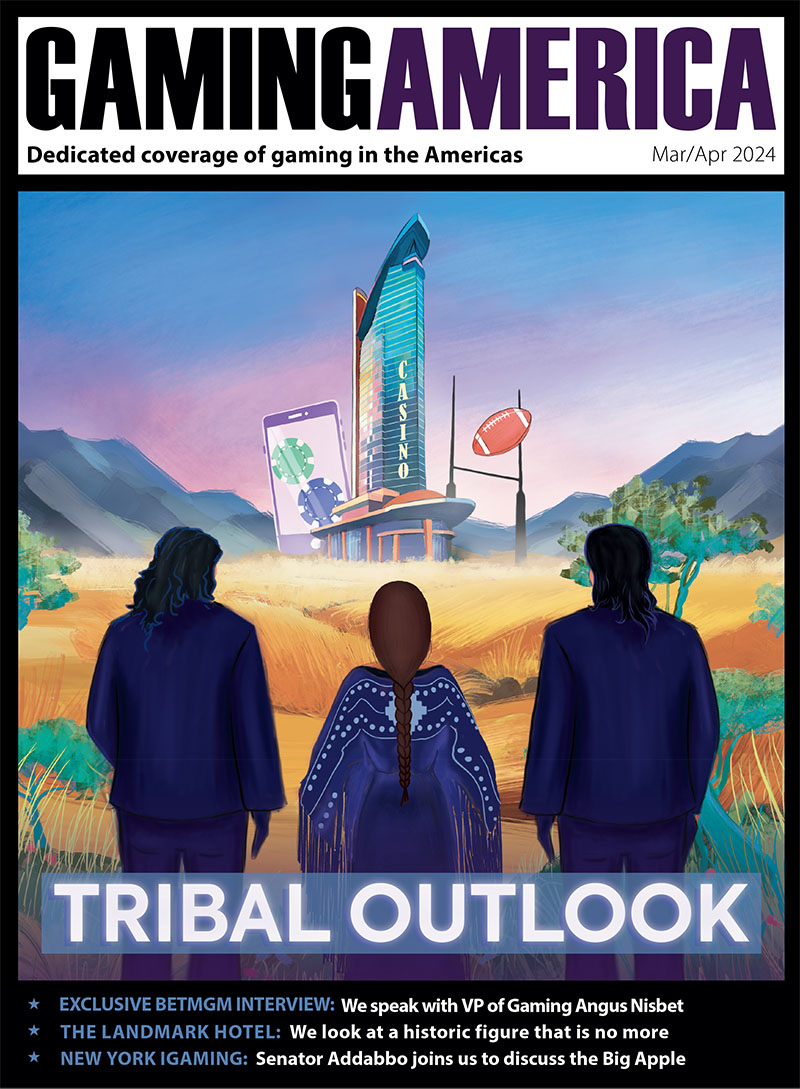
Few people have the sense of self and purpose to know exactly where their careers will take them. However, for E. Sequoyah Simermeyer, his deep roots in the community grew into an opportunity he had always hoped for. The Chairman of the National Indian Gaming Commission (NIGC) has always wanted to show his dedication to, and inspiration from, his greater Tribal community, to provide protection, governance and everlasting support for his people.
As an active member of the Coharie Tribe, based in the eastern part of North Carolina, Simermeyer had the chance to immerse himself in the culture, customs and guidance that shaped him as both a person and a regulator. His formative years created such a strong bond between the Chairman and the people he would eventually serve that Simermeyer told Gaming America, “I really I think I knew as a native person, through my own experiences and interactions with other Tribal communities, that I always wanted to try to work on behalf of, or work with, Tribal governments.”
Building on tradition
Simermeyer comes from a large family, which spans from where the Coharie Tribe resides in North Carolina, to the southwestern United States in smaller, Hispanic communities based in northern New Mexico and southern Colorado. His family moved from the Southwest to the East Coast when he was young, where he grew up as part of the Baltimore Indian community, but also frequently took trips down to the Coharie Tribe’s events.
Simermeyer said, “I was fortunate, in my experience growing up, to not only be close to my community in North Carolina and participate culturally with my family there in our activities and events, but also to be close to other Tribes on the East Coast and urban Indian communities as well.”
The autumn is a special, busy time of year for the Coharie Tribe. Simermeyer said some of his earliest experiences as a Coharie person were participating in annual fall gatherings; this September, he will take his children to the same events he loved as a boy.
He spoke fondly of the Coharie Tribal festivities planned each year, saying, “There’s a pow wow included, and some other cultural events. I also participated in a lacrosse exhibition as a young person. Lacrosse is a traditional game for a lot of Tribal communities.” When it came to wanting to represent his Tribe as part of his future career, the traditional, yearly gathering was incredibly influential.
“I think it really underscored for me the importance of the values in my own community: the importance of the strength and the role of family in reiterating leadership, and in developing perspectives on how you approach responsibilities and opportunities in your life.”
The desire to embody the spirit of his community led Simermeyer to achieve a Bachelor of Arts in Environmental Studies from Dartmouth College, then a Master of Environmental Law and Policy from Vermont Law and Graduate School, and finally a Juris Doctor from Cornell Law School. Before he became part of the NIGC, Simermeyer said, “Earlier in my academic career I focused on environmental studies and chemistry, and I wanted to play a role in trying to help Tribal governments be stewards of the resources that are important to Tribal communities’ own identity and place.”
Some of the people Simermeyer had the opportunity to learn from during his education and early life were the Tribal elders, who placed importance on the preservation of natural elements that have always been part of the Tribe’s native geography and home. He explained, “There are two main river systems that make up our territory and our lands; one is the Black River and one is the Coharie River.
There have been a lot of elders who have been persistent over many years and been able to help manage or restore the quality of those systems.” After law school, Simermeyer worked with a nonprofit organization called the National Congress of American Indians. There, he had the opportunity to lead the state-Tribal relations project, which “looked to develop relationships and collaboration opportunities between state lawmakers and Tribal leaders.”
He also spent time working on projects with the United Nations Organization of American States to develop a declaration on the rights of indigenous peoples. Moving to a federal role, Simermeyer was part of a team that responded to concerns and challenges faced by Tribal leaders, with the aim of addressing how they could best lead their communities.
He also gained perspective on a lawmaker's role while working as part of a Senate committee, including, “articulating policy objectives, and the role of regulators, which I later had the opportunity to become, and in carrying out and executing those objectives.”
Everything in his career flowed smoothly toward where the NIGC Chairman is today. Though the gaming industry was not yet part of Simermeyer’s plan, his next steps into gaming regulation came from solid foundations in regulatory and governing roles, bolstered by his eye for both detail and the bigger picture. Simermeyer nodded as he said, “I think my background experiences built into the opportunity to be in this unique role of the NIGC.”
Making it official

Simermeyer joined the NIGC in 2015, in an Associate Commissioner role, as per an appointment by the Secretary of the Interior. He commented on his start with the organization, “I think a lot of earlier experiences – whether it was through understanding inter-jurisdictional relationships, understanding relationships between Tribal states, knowing the role of federal officials and collaborating with Tribal leadership, or understanding the role of lawmakers and setting policy objectives – really helped when I first came to the commission as a regulator in 2015.”
That year was the first opportunity the Chairman had to work within the unique domain of gaming regulation. Even early on, Simermeyer and his colleagues at the NIGC were updating and refining the policy related to categorical exclusions for management agreements, where no construction was involved to “help focus resources and attention on environmental policy issues.”
Simermeyer was soon appointed as the Chairman of the NIGC by the President of the United States in 2019. As part of this role, he oversees the entire “Indian gaming footprint” of a little under 250 Tribal governments, which license about 515 gaming operations on Indian land across 29 states.
Simermeyer says each operation ranges in size and age, but it is clear from the way he speaks about his role that every operation is treated with equal care and dutiful regulatory attention. Simermeyer said, “I think it’s important for the NIGC to communicate externally about how we interpret policies and how we anticipate those policies having an impact on operations, as well as for us to understand how Tribal governments are envisioning those operations to grow and evolve in the future. Being consistent in our interpretations is a really important responsibility for a federal agency like the NIGC.”
As part of his role, the Chairman travels to and visits many of the Tribes within this large gaming footprint. The aim is to make the Commission and the leadership work they do “accessible to and part of” every Tribal community the NIGC serves. Simermeyer doesn’t have a favorite place he’s traveled to, but is continually enthusiastic about the differences he and the other members of the NIGC are able to see in various operations, partnerships and relationships throughout the Indian gaming landscape.
Every Tribal government is fundamentally different in both their structures and the roles they play, and every time Simermeyer has the duty to visit a new place within his jurisdiction, it’s always a good experience. Communicating, collaborating and having outreach with the community and stakeholders is very important to the executive. He said, “It’s part of the work we do with our on-the-ground regional offices as well.
Each time I get a chance to visit with the community or to meet with stakeholders, there’s always a new perspective that I learn and a new appreciation for the diversity that’s out there.” Just like the large variance in Tribal gaming and Tribal governments, Simermeyer says there is no typical day when working with the NIGC.
“It’s always been a little bit different, which has made the opportunity really exciting,” he said. As well as spending time gathering data and perspective from various operations throughout Indian Country to anticipate the needs of every Tribal gaming operation the best they can, Simermeyer and his colleagues with the NIGC have been focused on looking internally to operate more efficiently as an organization.
Parts of each day with the NIGC are dedicated to working with the leadership team, maintaining continuity and working closely together to devise local solutions. The Chairman said being responsive to both what the NIGC, and other Federal agencies involved in gaming, find in Indian Country is also an important part of the work they do.
The changing landscape
One of the areas of the NIGC’s focus, which came into much clearer view during Simermeyer’s first years as Chair, was the necessity of being prepared. Risk mitigation, though always a crucial part of the organization’s work, shifted from hypothetical planning around any potential natural disaster, to action plans for Tribes and their gaming operations during the Covid-19 pandemic.
Appointed Chair in 2019, Simermeyer ran the organization for only one pre-Covid year before both preparation and risk took on entirely new meanings. “The challenges were to work with Tribal governments to help articulate what their objectives and policies were going to be, in relation to their gaming operations,” Simermeyer said of the work initially, adding, “Soon after that, it grew into the pandemic and really underscored the role the agency can play in terms of supporting Tribes to develop their approach, to having standards in place to protect the environment, public health and the safety of the operations and employees.”
The NIGC has consulted with Tribes to shape how the Commission has looked at eight different areas of its regulations, including the completion of new regulations, which provide updated administrative flexibility where possible. Simermeyer said of the unexpected difficult time, “I’m really grateful that during the last few years the agency has been able to be responsive both to challenges and opportunities from the pandemic, as well as address uncertainties as best we can in technology areas.”
Guidance related to public health matters and technology were adopted by Tribes to help both the Commission, and the operations it looks after, navigate the next steps in decision making. In most discussions Gaming America has had with executives, regulators and lawmakers within the gaming industry this year, the biggest change within gaming isn’t always attributed to the pandemic, but instead to advancements in technology.

Communication both within a casino, as well as throughout the regulatory bodies looking after each gaming operation, has changed drastically. Casino management systems integrate all aspects of the gaming floor for dealers and other employees, while the NIGC seeks to streamline and improve regulations for a growing gaming workforce across the country.
The issue of cybersecurity also came up as a risk that will only increase in importance when it comes to mitigation. Simermeyer said, “We look for how regulatory bodies can be more effective in the way they’re meeting their responsibilities, including technology, but also including opportunities for lawmakers to reassess. They can look at how their workforce capacity at the regulatory level is able to anticipate and update their own regulations, and their own approach to regulation.”
One of the other milestones Simermeyer will also experience during his term as NIGC Chairman is the celebration of the Indian Gaming Regulatory Act’s (IGRA) 35th anniversary. Signed into law in October of 1988, IGRA established the entire regulatory structure for Tribal gaming within the US, including the creation of the NIGC and the promotion of gaming as a means for Tribal economic development and self-sufficiency.
Simermeyer reflected on the Act’s 35 years by saying, “We are trying to look critically at how a regulatory agency is going to ensure both cognitive operations and institutional knowledge pass on, as we hit these 20, 30, 35, 40-year milestones for a lot of operations.”
Updates to regulations, legislation and documentation are often processes which can take multiple drafts, thorough research and years before they come to fruition. Simermeyer agrees regulators must often be people of a special disposition, as they are able to enjoy those planning stages while keeping a crucial patience and dedication to the cause – which might also explain why he is a referee in his spare time (more on that later).
Simermeyer said, “It’s really important to remain focused on the broad mission we have as regulators, which is to protect Tribal assets throughout gaming. The way we’re able to do that is to be thoughtful and try to make the best decision we can with the information. That takes time.”The Chairman says the Commission has a rather unique role as both a regulatory and federal agency, with an obligation to work in a government-to-government relationship with Tribes.
As far as how Simermeyer and the NIGC make the best of that time, he said, “I think it’s important in the way we work methodically through new issues to be mindful of being transparent in the way we rely on earlier interpretations. We must collaborate and communicate with those who are impacted – particularly Tribal leaders – and we recognize the impact potential action might have on their ability to govern and exercise their authority.”
A unique relationship
IGRA is perhaps the chief difference between Tribal and commercial gaming. For Simermeyer, both IGRA and the pre-existing case law surrounding Indian gaming in the US established the Tribal gaming industry as “governmental gaming.” IGRA established five specific uses for Tribal gaming revenue as a way to meet a statutory policy objective to improve Tribes’ governing capacity and encourage sustainable, economic growth.
This distinct regulatory framework differs from commercial gaming operations, and allows for revenue from Tribal gaming to be used for: funding Tribal government programs, providing for the general welfare of the Tribe and its members, promoting Tribal economic development, donating to charitable organizations and aiding the funding of local government agencies. Commercial gaming revenue is also often used to fund state programs, like pensions and public education, but revenue taken in by casinos and other commercial for-profit gaming ventures may not be so strictly structured.
Simermeyer also noted the inter-jurisdictional relationships necessary between state and Tribal governments for Indian gaming operations to flourish, saying that IGRA’s provision for these relationships “reflects a lot of the unique discussion and debate that was taking place when the Act itself was first passed.” The Chairman added, “Those multiple layers and multi-jurisdictions make Indian gaming highly regulated, like a lot of the gaming industry, but also make it unique, because of Indian gaming having that federal regulatory role with the NIGC.”
Similarities found between the commercial and Tribal gaming industries include the desire to evolve and change as the industry begins to support new types of legalized, regulated gaming. Commercial operators also call for a healthy, regulated market but the role that Tribes play in managing their own opportunities makes a significant difference, as far as Simermeyer is concerned.
Though he is the only person in his family to serve a role within the unique space of Tribal gaming, he says an appreciation for the overall Tribal government and culture have always been part of his life. “There’s a lot of inspiration I’ve had from individuals in the Tribe: either who’ve worked in state government leadership, or individuals who’ve been passionate about working to restore our waterways and our community there.”
When Simermeyer is not maintaining regulations within the gaming industry, he spends his time regulating another kind of game: lacrosse. From elected official to athletic officiant, the Chairman’s childhood sport is still part of his life, but now he’s a referee. “Still regulating, that’s right!” he laughed, “It’s been a great way to stay active in a sport that I really enjoy, and I think outside of the sport itself, it’s a good way to learn to focus on a task and do your best, but know that you always have room to improve.”
Also part of Simermeyer’s busy schedule is staying active within the Coharie Tribe. He places importance on community awareness and understanding with his young family, as these values were so important to him while growing up. His family’s favorite thing to do is visiting other relatives and extended family throughout the US.
Simermeyer has three children of his own of “middle school age and younger,” and also mentioned many cousins, aunts and uncles in North Carolina, as well as his wife’s family in Oklahoma, and his mother’s large family – which includes 13 brothers and sisters. It’s clear this sense of family and self translates fully into Simermeyer’s approach, within both regulating and enjoying the operations of the larger Tribal community.
He said, “Particularly I have an appreciation for the sacrifices and efforts my own parents and grandparents have made to really expose me as a young person to my family. I think it’s a way to instill confidence in your identity and what makes you unique as a person – culturally, with your spiritual identity and your relationship and responsibility to serve others.”
As for the service Simermeyer has given during his time at the NIGC, while he has reached the end of his term, he may continue to serve until a successor is appointed. The current Chairman reflected that another aspect of his role is diplomacy. He said, “As a federal entity working with Tribal governments, but also as a regulatory body, it’s important to be diplomatic and transparent, and to have a collaborative approach to be efficient in the way the agency regulates.”
In his role within the NIGC, Simermeyer also states that patience has been more than a virtue, serving as an important and necessary practice for regulators in an ever-changing industry. Understanding how Indian gaming will continue to evolve over time is part of Simermeyer’s role now, as much as it will be part of the role of any future Chair. He concluded, “Tribal governments, who are stewards of and pursue gaming, are always looking to protect their sense of what this resource provides for their community.”
















